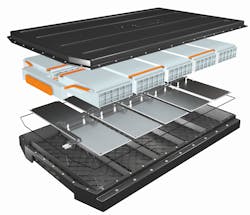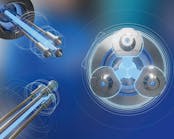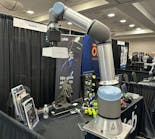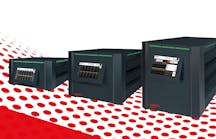By Bruce Geiselman
Production of electric vehicle (EV) batteries will grow in coming years as automakers have pledged to electrify large portions of their fleets, and plastics are likely to play an increasingly significant role in their production.
GM, for example, plans to offer 30 all-electric models globally by mid-decade and 40 percent of the company’s U.S. models will be battery EVs by the end of 2025. The automaker worked with the Environmental Defense Fund to develop a shared vision of an all-electric future and an aspiration to eliminate tailpipe emissions from new light-duty vehicles by 2035.
GM isn’t alone. Ford expects 40 percent to 50 percent of its global vehicle volume to be fully electric by 2030.
Forbes published an online article that outlines “Every Automaker’s EV Plans Through 2035 And Beyond.”
Related: EVs fuel market for Entek's battery separators
As the demand for lithium-ion batteries in EVs grows, manufacturers are using more plastic parts. Most batteries intended for light vehicle use now have 50 percent more plastic than they did 10 years ago, said Rich Reed, VP of sales and marketing at Performance Plastics, a custom precision injection molder of high-performance materials, including perfluoroalkoxy, polyetherimide and polyphenylsulfone, that are used in lithium-ion batteries. Some batteries have entirely plastic formulations, including polymeric electrolytes, Reed said.
“We have been involved in producing parts for lithium-ion batteries and packaging, and applications that are proprietary, but they go inside the cell for electrical insulation,” Reed said.
Plastic components incorporated in batteries include separators, gaskets and casing components. Plastics have good shock-absorbing characteristics and prevent damage to the basic cell unit from minor accidental impacts. Also, plastics have high temperature resistance, corrosion-resistance and are electrical insulators, which is ideal for preventing short-circuiting and “rapid unscheduled disassembly,” a euphemistic term for battery fires and explosions that can result from thermal runaway.
Certain polymers are electrostatic-discharge-safe (ESD), meaning they are nonconductive but can dissipate static electricity to reduce the risk of thermal runaway.
Battery manufacturers also are shifting to plastic components in part because of the significant weight savings compared with metal components, Reed said. Significant weight savings can be achieved when shifting from metal battery packaging to plastics.
“A typical composite can be optimized and designed very cost effectively,” Reed said. “Compared to even aluminum, you could get a 35 percent weight reduction.”
Plastic parts also may reduce battery production costs and may eventually replace most metallic components of batteries, Reed said.
The shift toward plastic in battery construction already is under way, and the research is ongoing. Several car manufacturers have taken up this challenge and successfully reduced vehicle weight with the help of lightweight composite construction. However, research is continuing into new materials to make the shift more cost-effective and to reduce weights even further.
Sabic introduces resins for battery modules
Sabic, a Saudi Arabian multinational chemical company, has also been studying how to lightweight EV batteries while improving flame retardance and impact resistance.
In December, Sabic announced it was launching two new grades of Noryl resins designed for EV battery modules. In traditional EV battery designs, multiple cells are electrically combined to form modules. Multiple modules are then combined in series configurations and housed within the battery casing or packaging, consisting of tray and cover assemblies.
Noryl NHP6011 and NHP6012 are new glass-fiber-reinforced resins featuring a proprietary polyphenylene ether copolymer. They support demand for lighter, thinner and more crash-resistant battery modules and offer thin-wall molding capability to reduce weight and accommodate more battery cells, helping to extend vehicle range and performance, the company said.
“Optimization of batteries is crucial to expanding adoption of electric vehicles and realizing the full sustainability benefits of e-mobility,” Darpan Parikh, global product management leader for resins and compounds at Sabic, said in a press release. “By helping to enhance EV batteries through better safety, higher energy density and lower weight, our new Noryl resins can also help manufacturers increase the consumer appeal of their vehicles.”
The resins address stricter flame-retardance requirements now in force in Europe and Asia, and offer high impact strength for crash protection, Sabic said. Noryl NHP6011 and NHP6012 resins provide non-chlorinated/non-brominated flame retardance that meets UL 94 V-0 flame retardance standards at 1.5 mm, according to Sabic.
Manufacturers also are striving to reduce the size of EV batteries to fit more cells in existing or smaller spaces to increase vehicle power and range. The dimensional stability and good flow properties of the new resins enable thin-wall designs for cell frames, retainers and battery pack top covers. The materials provide excellent dielectric performance with a comparative tracking index of 2 to help avoid electrical shorts among tightly packed cells.
The two products differ in their glass-fiber loadings to accommodate specific customer requirements for stiffness.
The Noryl NHP6011 and NHP6012 also provide excellent resistance to acid as compared to PC and better resistance to moisture as compared to polyamide, the company said.
The new grades are available globally.
Kautex Textron and Lanxess collaborate
In Germany, specialty chemicals company Lanxess and Kautex Textron, an automotive supplier, have collaborated for several years to research whether battery housings for EVs can be designed and manufactured from technical thermoplastics.
They announced in November that as part of a demonstration project, they developed an all-plastic battery housing with a weight in the range of 88 pounds to 132 pounds using glass-fiber-reinforced composites. The housing, measuring 4.6 feet in both length and width, weighs significantly less than comparable steel and aluminum housings, the companies said. It consists of a housing tray with crash structure, a housing cover and an underrun (underbody) protection.
“As a first step, we have completely dispensed with the use of metallic reinforcement structures while proving we can commercially produce these complex large components,” Felix Haas, director of product development at Kautex Textron said.
“Going forward, Kautex and Lanxess want to use the results of the cooperation to enter into development projects for series production with automotive manufacturers,” Christopher Hoefs, project manager e-Powertrain at Lanxess said.
The battery housing was developed as part of a demonstration project using a single-stage direct long-fiber thermoplastic (D-LFT) molding process. The process is unique to compression molding and is used for mid- to large-size battery housings for EVs and plug-in hybrid electric vehicles, according to Lanxess.
Lanxess has optimized its Durethan B24CMH2.0 PA6 resin for the D-LFT molding compound. Kautex Textron compounds the PA6 for the process with glass-fiber rovings. Local reinforcement of the housing structure is carried out using Tepex Dynalite continuous fiber-reinforced thermoplastic composites from Lanxess, the company said.
“The process enables shorter and thus more economical cycle times than the processes in which steel or aluminum are processed,” Haas said.
Plastics also are corrosion-resistant and electrically insulating, meaning there is a reduced risk of the system short circuiting or arcing, according to the companies. The lower weight of the plastic housing can help boost the range of EVs.
Plastic housings, consisting of a tray and cover, must also be designed to absorb a significant amount of energy in the event of a crash, and be flame retardant in case of a vehicle fire or thermal runaway of the electrical cells.
Lanxess and Kautex Textron continue to optimize the structural design and to carry out the majority of the development work virtually to save costs associated with prototype designs.
Bruce Geiselman, senior staff reporter
Contact:
Kautex Textron GmbH & Co. KG, Bonn, Germany, 49 228 488-0, hwww.kautex.com/en.
Lanxess AG, Cologne, Germany, 49 221 8885-0, www.lanxess.com.
Performance Plastics, Cincinnati, (513) 321-8404, www.performanceplastics.com
Sabic, Houston, 800-845-0600, www.sabic.com/en
Bruce Geiselman | Senior Staff Reporter
Senior Staff Reporter Bruce Geiselman covers extrusion, blow molding, additive manufacturing, automation and end markets including automotive and packaging. He also writes features, including In Other Words and Problem Solved, for Plastics Machinery & Manufacturing, Plastics Recycling and The Journal of Blow Molding. He has extensive experience in daily and magazine journalism.






